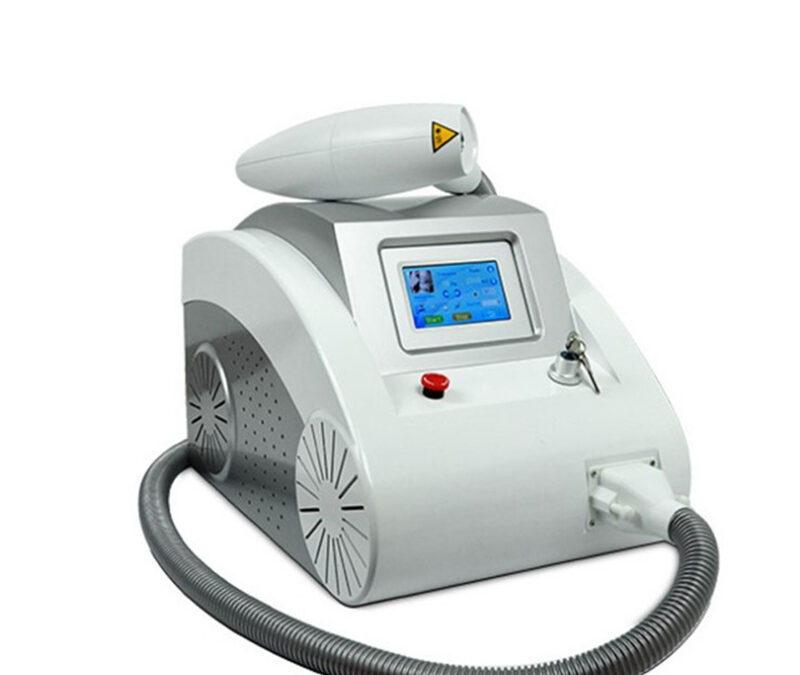Laser tattoo removal face cleanser Machine EN067
Efficient Laser Picosecond Tattoo Removal Machine EN056
3 in 1 IPL SHR OPT ND YAG Laser Tattoo Removal Multifunction Laser Hair Removal Device EN100
Do you currently regret getting a tattoo?
Are you planning to get rid of it quickly?
You should think about obtaining a laser tattoo removal procedure if you are.
Tattoos are permanent, but laser tattoo removal is a quick, non-invasive procedure that can reduce or even eliminate the appearance of unwanted tattoos.
If you’re considering laser tattoo removal, here are some things you should know about it.
This article will discuss what you need to know about laser tattoo removal. You’ll learn about how it works, how much it costs, how long it takes, and more.
What is laser tattoo removal?
Laser tattoo removal is a procedure that uses a laser beam to break down the ink particles in your tattoo so that they can be removed from the skin.
Laser tattoo removal can be used to remove any color of ink: black, blue, green, red, or purple. The procedure involves shooting beams of light into the skin and breaking up the pigment used in the tattoo. The ink then travels through your lymph system until it reaches your liver, where it’s filtered out by your body’s immune system — just like any other foreign substance.
It takes anywhere from three to eight treatments to completely remove the appearance of a tattoo, depending on its size and color.
Laser tattoo removal is non-invasive and doesn’t require any incisions or injections. The results are typically effective.
How it works
With the help of a powerful light beam, lasers remove tattoos by dissolving the pigment colors. The easiest color to remove from a tattoo is black because the pigment absorbs all laser wavelengths. It depends on the pigment color and whether some kind of laser is used to eliminate other colors. Scarring is frequently left behind by tattoos, which can never truly be removed.
With the help of a powerful light beam, lasers remove tattoos by dissolving the pigment hues. The easiest color to remove from a tattoo is black because the pigment absorbs all laser wavelengths. Only some lasers, depending on the pigment color, can treat other colors.
Make sure to first schedule a consultation with a knowledgeable dermatologist who can evaluate your tattoo and provide you with information on how the procedure is done. The number of treatments you need will depend on the color(s), size, and age of your tattoo.
The tattoo removal method will also be influenced by the color of your skin and how deeply the tattoo pigment is embedded in your skin.
What happens during a laser tattoo removal
What to anticipate from a laser tattoo removal session is as follows:
You will be given a set of safety eye shields.
Your skin’s reaction to the laser will be evaluated by the technician.
Only the tattoo pigment will be consumed by the laser’s powerful light pulses as they pass through the upper layers of your skin.
Fewer pulses will be needed to get rid of smaller tattoos than significant ones, and vice versa. In any scenario, several sessions would be necessary to completely remove a tattoo. The appearance of your tattoo should keep reducing with each visit.
It is true that laser tattoo removal is quite painful, most individuals don’t need to be given an anesthetic. You might wish to use a topically applied anesthetic lotion beforehand, depending on where your tattoo is located.
Utilize a cold compress to calm the treated part of your skin immediately after the procedure. Apply an antibiotic lotion or ointment as well as gauze pad it for preservation. Make sure your skin is sun-protected whenever you’re outside.
What are the side effects of laser tattoo removal?
The main risk associated with laser tattoo removal is scarring. A large percentage of people who undergo this procedure will experience some degree of scarring, which can range from mild to severe. This can be due to the size and location of the tattoo being removed as well as other factors such as age or skin color.
The severity of the scarring depends on several factors including:
Age – Younger patients tend to heal better than older ones because they have less collagen breakdown over time.
Skin color – People with darker skin tones tend to have more severe scars than those with lighter skin. This is because darker colors absorb more light during treatment and thus require longer sessions to get rid of them completely.
Location – The location where you had your tattoo placed also plays a role in how much scarring you will experience after treatment has ended. Areas where there are fewer blood vessels present such as your back or chest area are less likely to result in significant scarring compared with other areas.
Laser tattoo removal is generally safer than other tattoo removal methods like excision, dermabrasion, or salabrasion because it directly addresses the coloring in the tattoo. Additionally, there are barely any adverse effects. But, consider these factors before choosing:
1.An infection could develop where you removed your tattoo. Additionally, there is a slight possibility that it will leave a permanent scar.
2.Your tattoo probably won’t be totally removed. That’s because certain colors can be easily gotten rid of than others. For example, laser therapy works effectively on tattoos that are black and blue.
3.A possible result is hypopigmentation, where the treated skin is brighter than the surrounding skin.
4.In fact, after treatment, cosmetic tattoos like eyeliner, lip liner, and eyebrows may get darker. Over time, they do tend to deteriorate.
5.Additionally, most people should anticipate experiencing side effects as part of the tattoo removal procedure. The immune response that aids in removing the ink from the skin is aided by a few side effects.
Every patient should be prepared for some degree of negative effects. The most common side effects include:
Scabs
Redness
Bruising
Tenderness
Blistering
Hypopigmentation
Hyperpigmentation
Swelling
How many laser tattoo removal treatments is required?
It may require 8 to 15 sessions, spaced at least 8 weeks apart, to completely remove a tattoo. It varies obviously; some take less than eight sessions, while others take longer than fifteen. Depending on the patient and tattoo, it may be necessary to space out sessions by more than 8 weeks for the best results.
Scarring is more likely to happen after a quick tattoo removal. This is because it is forceful, and aggressive tattoo removal increases the chance of scarring. With delicate removal leading to little scarring, good clinics should care about the skin they are treating, but it usually takes time.
Although there is a very real chance that this treatment can leave scars, the risks will be very low if it’s performed by an experienced dermatologist.
How much does laser tattoo removal cost?
Laser tattoo removal cost is dependent on several factors, so you should inquire about the pricing before your initial session. The procedure employed for the removal is a significant factor.
Tattoo removal costs vary depending on the procedure used, the size of the tattoo, any existing scars, the body part being treated, the color of the skin, and the depth and type of ink used.
Laser tattoo removal typically costs $423. The price of a significant piece of art can be $4,000 or more.
Insurance does not pay for tattoo removal price, however, if you meet the requirements, several community organizations provide free removal.
Does tattoo removal hurt?
Laser tattoo removal typically results in some uneasiness. However, many claim that it doesn’t hurt as bad as they thought.
Contrary to popular assumption, tattoo removal is usually not as painful as getting a tattoo, according to the majority of patients.
When talking to patients about their pain, it’s crucial to let them know that while they might feel some discomfort, the pain is usually moderate and tolerable.
The great majority of tattoo removal service companies provide some kind of skin calming during the procedure. Your dermatologist can remain competitive, offer better patient care, and have higher patient satisfaction by providing skin numbing throughout the treatment.
Conclusion
Undesirable tattoos can be removed using the safe and efficient laser tattoo removal procedure.
The process can take anywhere from a few sessions to dozens, depending on the size and color of the tattoo, as well as your skin type and other factors.
It is a process that uses light energy to break down the ink in your tattoo. It can be used on both new and old tattoos, but it’s more effective on darker tattoos. The laser breaks up the pigment particles in your skin and allows your body to naturally remove them over time.
Your doctor will discuss any risks associated with laser tattoo removal with you before treatment. Risks are minimal if you have healthy skin and have received proper medical clearance from your primary care physician or dermatologist.
To ensure you get the proper care and attention, pick a credible dermatologist or cosmetic surgery provider.
Because tattoo removal is often a matter of personal preference, the majority of insurance companies won’t cover it unless it is medically necessary. If you’re thinking about getting a tattoo removed, make sure to talk about the additional expenses up front and get a written estimate of all fees before the procedure is carried out.

